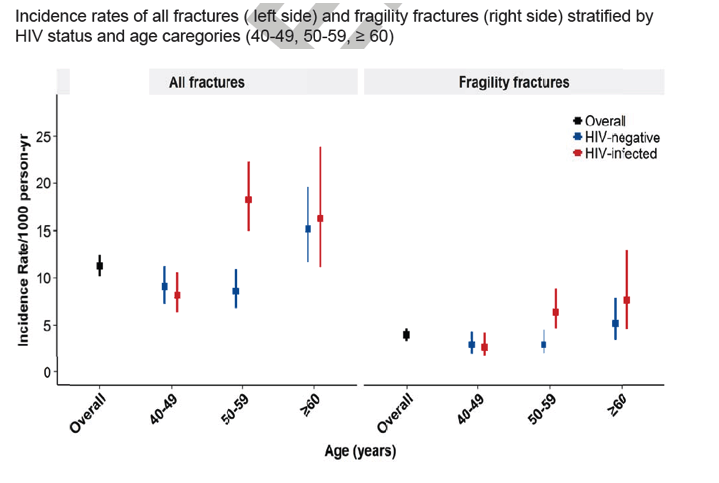| |
An Increased Rate of Fracture Occurs a Decade Earlier in HIV+
Compared to HIV- men in the Multicenter AIDS Cohort Study (MACS)
|
| |
| |
Download the PDF here
From Jules: what you see below in the graph is that fracture rates increase a lot at 50-59 years old in HIV+ but not in HIV-neg, so increased fractures start 10 years earlier in HIV+
Presented at CROI/2016 - Fractures Occur at a Younger Age in HIV+ Men in
the Multicenter AIDS Cohort Study
http://www.natap.org/2016/CROI/croi_160.htm
Bone & HIV...3-4 Fold increased osteoporosis
& fractures, a worrisome bone future....http://www.natap.org/2016/HIV/041316_02.htm
AIDS April 3 2017
"Fracture rates are higher among HIV+ compared to HIV- persons and increase
proportionally with advancing age (28).....Amongst several risk factors investigated, we found that hypertension was an
independent predictor of all fractures with similar trends for the outcome of fragility
fracture."
Objectives: To determine the incidence and age-related fracture risk among HIV-infected (HIV+) and uninfected men (HIV-). To evaluate factors independently associated with fracture risk.
Design: Prospective, multicenter cohort study of men with or at risk for HIV.
Methods: Outcome measures: 1) all fractures (excluding skull, face, digits) and 2) fragility fractures (vertebral column, femur, wrist, humerus) were collected semiannually in 1221 HIV+ and 1408 HIV- men >= age 40. Adjusted incident rate ratios (aIRR) with an interaction term for age (40-49, 50-59, >=60 years) and HIV serostatus were estimated with Poisson regression models accounting for additional risk factors.
Results: Fracture incidence increased with age among both HIV+ and HIV- men. While there was no significant difference in fracture incidence by HIV serostatus among men aged 40-49 years, the HIV+ men aged 50-59 years had a significantly higher incidence of all fractures (aIRR = 2.06 [1.49, 2.84]) and fragility fractures (aIRR = 2.06 [1.21, 3.50]) compared with HIV- participants of similar age. HIV modified the effect of age on all fractures (p = 0.002) but did not significantly modify the effect for fragility fractures (p = 0.135). Hypertension increased the rate of all fractures by 32% after adjustment for covariates (aIRR = 1.32 [1.04, 1.69]).
Conclusions: Fracture incidence increased with age among HIV+ and HIV- men but was higher among HIV+ men. A significant increase in fracture incidence was found among 50-59-year-old HIV+ men, highlighting the importance of osteoporosis screening for HIV infected men above the age of 50.

|
|
| |
| |
|
|
|